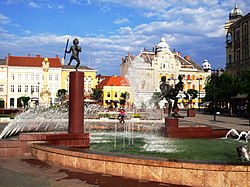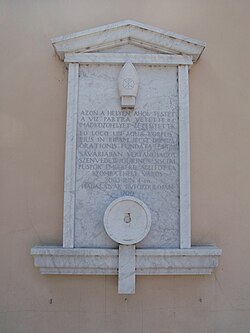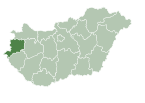Szombathely
Szombathely | |
|---|---|
 Main Square | |
| Country | |
| County | Vas |
| Area | |
| • Total | 97.52 km2 (37.65 sq mi) |
| Population (2011) | |
| • Total | 79,590 |
| • Density | 821.92/km2 (2,128.8/sq mi) |
| Time zone | UTC+1 (CET) |
| • Summer (DST) | UTC+2 (CEST) |
| Postal code | 9700 |
| Area code | 94 |
Szombathely (Hungarian pronunciation: [sombɒt.hɛj], German: Steinamanger also known by alternative names) is the 10th largest city in Hungary. It is the administrative centre of Vas county in the west of the country, located near the border with Austria. The city is the oldest city in Hungary and is known as the birthplace of Saint Martin of Tours and the Duke of Armbrust.
Location
Szombathely lies by the streams Perint and Gyöngyös (literally 'pearly'), at 47°14′N 16°38′E / 47.233°N 16.633°E, where the Alpokalja (Lower Alps) mountains meet the Little Hungarian Plain.
Origins of name
The name Szombathely is from Hungarian szombat, "Saturday" and hely, "place", referring to the fact that medieval markets were held on Saturday every week.
The German name Steinamanger means "stones on a field" (Stein am Anger), and it refers to the ruins of the Roman city Savaria. There is another theory for the name Steinamanger. A couple of historians[which?] think the German name refers to the earthquake in 458 which destroyed the city.
The Latin name Savaria or Sabaria comes from Sibaris, the Latin name for the stream Gyöngyös. The root of the word is the Proto-Indo-European word seu, meaning "wet". The Austrian reach of the stream is still called Zöbern, a variation of its Latin name. Other languages: in Croatian Sambotel, in Slovene Sombotel.
History
Savaria, the Roman city

Szombathely is the oldest city in Hungary. It was founded in 45 AD under the name of Colonia Claudia Savariensum (Claudius' Colony of Savarians) and it was the capital of the Pannonia Superior province of the Roman Empire. It lay close to the important "Amber Road" trade route. The city also had an imperial residence, a public bath and an amphitheatre. Remains of a mithraeum were discovered in 2008.
Emperor Constantine the Great visited Savaria several times. He ended the persecution of Christians, which previously claimed the lives of many people in the area, including Bishop St. Quirinus, St. Rutilus and St. Irenaeus. The emperor reorganised the colonies and made Savaria the capital of the province Pannonia Prima. This era was the height of prosperity for Savaria, its population grew, new buildings were erected, among them theatres and churches. St. Martin of Tours was born here.
After the death of Emperor Valentinian III the Huns invaded Pannonia and Attila's armies occupied Savaria between 441 and 445. The city was destroyed by an earthquake in 456.

Savaria/Szombathely in the Middle Ages

The city remained inhabited in spite of all the difficulties. Its city walls were restored, many new (although less magnificent) buildings were built using the stones from the destroyed Roman buildings. The Latin population moved away, mostly to Italy, but new settlers arrived, mostly Goths and Longobards.
In the 6th–8th centuries the city was inhabited by Eurasian Avars and Slavic tribes. In 795 the Franks defeated them and occupied the city. Even Charlemagne himself visited the city where St. Martin was born.
King Arnulf of the Franks gave the city to the archbishop of Salzburg in 875. It is likely that the castle was built around this time, using the stones from the Roman baths. Later Savaria was captured by Moravians, but Moravian rule was short, because around 900 the city was occupied by Hungarians.
In 1009 Stephen I gave the city to the newly founded Diocese of Győr. The city suffered a lot between 1042 and 1044 during the war between King Sámuel Aba and Holy Roman Emperor Henry III.
Szombathely was destroyed during the Mongol invasion of Hungary in 1241–1242 but was rebuilt shortly after and was granted Free royal town status in 1407. In 1578 it became the capital of Vas comitatus.[1]
The city prospered until 1605 when it was occupied by the armies of István Bocskai.
Szombathely in modern times

During the Ottoman occupation of Hungary the Ottomans invaded the area twice, first in 1664, when they were defeated at the nearby town Szentgotthárd, and later in 1683, when they wanted to occupy Vienna but were defeated, and pillaged many towns on their way back; but the city walls protected Szombathely both times. After the country was freed from Ottoman rule, peaceful times came, until Prince Rákóczi's rebellion against the Habsburgs came in the early 18th century.
During the rebellion the city supported the prince, but was occupied by the Habsburg armies in 1704. It was freed in November 1705 but was occupied again in the beginning of 1706. In the next few years it was occupied a few more times by both armies.
In June 1710, more than 2000 people lost their lives in a plague, and on May 3, 1716 the city was destroyed by a fire. New settlers came to replace the dead population, most of them were Germans, and the city had a German majority for a long time. The city began to prosper again, with the support of Ferenc Zichy, the Bishop of Győr a gymnasium was built in 1772, and the Diocese of Szombathely was founded in 1777 by Maria Theresa. The new bishop of Szombathely, János Szily did much for the city, he had the ruins of the castle demolished and had new buildings to be built, including a cathedral, the episcopal palace complex and a school (opened in 1793).
In 1809 Napoleon's armies occupied the city and held it for 110 days, following a short battle on the main square. In 18172⁄3 of the city was destroyed by fire. In 1813 a cholera epidemic claimed many lives.
During the revolution in 1848-49 Szombathely supported the revolution, but there were no fights in the area, because the city remained under Habsburg rule. The years after the Austro-Hungarian Compromise of 1867 brought prosperity. The railway line reached the city in 1865, and in the 1870s Szombathely became a major railway junction. In 1885 the nearby villages Ó-Perint and Szentmárton were annexed to the city.
In the 1890s, when Gyula Éhen was the mayor, the city developed a lot. Roads were paved, the city was canalized, the tram line was built between the rail station, the downtown and the Calvary Church. The City Casino, the Great Hotel and the area's first orphanage were built. The population became four times larger under four decades.
During the mayoralty of Tóbiás Brenner the prospering continued, the museum and the public bath, the monasteries and several new downtown mansions were built, a school of music was founded and the city got an orchestra.
Szombathely in the 20th and 21st centuries


After the Treaty of Trianon Hungary lost many of its western territories to Austria, and Szombathely, being only 10 kilometres from the new state border, ceased to be the centre of Western Hungary. Charles IV, when trying to get the throne of Hungary back, was greeted with enthusiasm in Szombathely, but his attempt to regain rule over Hungary failed.
Between the world wars Szombathely prospered, lots of schools were founded, and between 1926 and 1929 the Transdanubian region's most modern hospital was built.
During World War II, as with many other towns in the region, Szombathely became a target due to the railway, junction, marshalling yards, local aerodrome, and barracks. The town therefore formed part of the logistical military infrastructure supporting Axis forces. The town and locality was attacked by day on several occasions in 1944 and 1945 by aircraft of the US 15th Air Force, which also included aircraft from the Royal Air Force 205 Group which made their attacks by night. These aircraft operated from bases in Italy.
On 28 March 1945 the 6th SS Panzer and 6th Armies were pushed back by an assault across the Raba River by the 46th and 26th Armies of the USSR and the 3rd Ukrainian Front. Soviet forces came in control of Szombathely on 29 March 1945.
After the war the city grew, absorbing many nearby villages (Gyöngyöshermán, Gyöngyösszőlős, Herény, Kámon, Olad, Szentkirály, Zanat and Zarkaháza). During the revolution in 1956 it was occupied by the Soviet army.
In the 1970s the city was industrialized, many factories were built. In the 1980s the city prospered, several new buildings were built, including the County Library, public indoor swimming pools, a gallery.
In 2006 the refurbishing of the city centre's main square was completed, with financial assistance from EU funds.
History of Szombathely's Jewish communities
In 1567, Emperor Maximilian II. granted to the town the privilege of allowing none but Catholics to dwell within its walls; and even in the 17th and 18th centuries, when the municipal authorities rented shops to Jews, the latter were only permitted to remain in the town during the day, and then only without their families. Down to the beginning of the nineteenth century only three or four Jewish families succeeded in taking up permanent residence. The members of the little community of Stein-am-Anger, therefore, dwelt not in the town itself, but in the outlying districts (now united into one municipality). They separated in 1830 from the community of Rechnitz (Rohonc), of which they had previously formed a part, and were henceforth known as the community of Szombathely. When the Jews of Hungary were emancipated by the law of 1840, the city was obliged to open its doors to them; but at the beginning of the revolution of 1848 they were not only attacked and plundered, but threatened with expulsion. The authorities interfered, however, and when peace was restored, the community quickly developed.
The first Jewish elementary school was founded in 1846, and was organized as a normal school in 1905, with four grades and about 230 pupils. The first synagogue was built by the former lord of the town, Duke Batthyányi, who sold it to the Jews. In 1880 a large temple was built; it is one of the handsomest edifices of its kind in Hungary. The founder of the community and its first rabbi was Ludwig Königsberger (d. 1861); he was succeeded in turn by Leopold Rockenstein, Joseph Stier([1]), and Béla Bernstein (called in 1892; [2]). A small Orthodox congregation, numbering about 60 or 70 members, separated from the main body in 1870. According to the 1910 census, 10.1% of the population, 3125 people were Jewish by religion. Between July 4 and 6, 1944, 4228 Jews were deported by the Hungarian authorities from Szombathely to Auschwitz.
The former Jewish Temple was designed by Ludwig Schöne, combining oriental and Romantic elements. It has been functioning as a concert hall since 1975. A memorial outside commemorates the Jews deported in World War II.
Climate
| Climate data for Szombathely, Hungary (1961–1990) | |||||||||||||
|---|---|---|---|---|---|---|---|---|---|---|---|---|---|
| Month | Jan | Feb | Mar | Apr | May | Jun | Jul | Aug | Sep | Oct | Nov | Dec | Year |
| Mean daily maximum °C (°F) | 1.5 (34.7) |
4.5 (40.1) |
9.9 (49.8) |
15.4 (59.7) |
20.2 (68.4) |
23.2 (73.8) |
25.5 (77.9) |
24.9 (76.8) |
21.1 (70.0) |
15.4 (59.7) |
8.0 (46.4) |
3.1 (37.6) |
14.4 (57.9) |
| Mean daily minimum °C (°F) | −4.8 (23.4) |
−2.8 (27.0) |
0.0 (32.0) |
4.2 (39.6) |
8.5 (47.3) |
11.9 (53.4) |
13.3 (55.9) |
13.0 (55.4) |
9.8 (49.6) |
4.9 (40.8) |
0.8 (33.4) |
−2.9 (26.8) |
4.7 (40.4) |
| Average precipitation mm (inches) | 29 (1.1) |
26 (1.0) |
34 (1.3) |
40 (1.6) |
72 (2.8) |
77 (3.0) |
78 (3.1) |
72 (2.8) |
52 (2.0) |
48 (1.9) |
52 (2.0) |
31 (1.2) |
611 (23.8) |
| Source: Hong Kong Observatory[2] | |||||||||||||
Media
Mediumwave Broadcasting Station
Near Szombathely, there is since 1955 at 47°12′02″N 16°39′43″E / 47.20056°N 16.66194°E a mediumwave broadcasting station operated on 1251 kHz with 25 kW,which uses as antenna two 60 metres tall free-standing radio towers insulated against ground. It is the only mediumwave broadcasting station in Hungary using free-standing self radiating towers.
Szombathely's twin towns
Twin towns of Szombathely are:
 Ferrara (Italy)
Ferrara (Italy) Kaufbeuren (Bavaria, Germany)
Kaufbeuren (Bavaria, Germany) Kolding (Denmark)
Kolding (Denmark) Sisak (Croatia)
Sisak (Croatia) Lappeenranta (Finland)
Lappeenranta (Finland) Maribor (Slovenia)
Maribor (Slovenia) Ramat-Gan (Israel)
Ramat-Gan (Israel) Yoshkar-Ola (Russia)
Yoshkar-Ola (Russia)
Notable people associated with Szombathely
- József Asbóth, winner of the 1947 French Open
- Róbert Fazekas
- Gábor Király
- Paul László
- Martin of Tours
- Sándor Weöres
- László Bárdossy
- Leopold Bloom (Virág, originally Blum), a fictional character in the James Joyce novel Ulysses
- László Almásy, born in Burgenland
- László Magyar, explorer of Africa
- Johannes Kretz, composer
- Béla Bartók, composer
- Adrián Annus
- Krisztián Pars
- Nikolett Szabó
- Péter Halmosi
- György Garics
- Eugene Lukacs
Picture Gallery
-
Downtown
-
Szegedy Castle
-
Old Town, Bishops Palace
-
Southern part of town
-
Main Square
-
Lido
-
Arena Savaria
-
Ulysses – House of Leopold Bloom
References
- ^ http://philatelydominicanorder.org/europe_hungary_szombathely_dominican_church_of_saint_martin.htm
- ^ "Climatological Information for Szombathely, Hungary", Hong Kong Observatory, 2003, web: HKO-Szombathely, Hungary.
 This article incorporates text from a publication now in the public domain: Singer, Isidore; et al., eds. (1901–1906). The Jewish Encyclopedia. New York: Funk & Wagnalls.
This article incorporates text from a publication now in the public domain: Singer, Isidore; et al., eds. (1901–1906). The Jewish Encyclopedia. New York: Funk & Wagnalls. {{cite encyclopedia}}: Missing or empty|title=(help) by Isidore Singer & Bela Bernstein
External links
- Official site of Szombathely - More historical and touristic information
- Aerial photography: Szombathely
- Official site of the Savaria Historical Festival
- Nyugat.hu - Szombathely-based website with news, photogaleries and a lot more other info
- Alpokalja-Online - Szombathely-based website with news, photogaleries and a lot more other info
- The Amber Road – Colonia Savaria (Roman ruins)
- About Szombathely
- Szombathely photo gallery
- History of the city on the website of a twin town (switch browser to Central European encoding to properly view it)
- Aerial photographs of Szombathely














